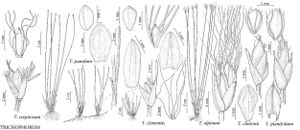Trichophorum
Syn. Pl. 1: 69. 1805.
Herbs, perennial, cespitose, rhizomatous or not. Culms trigonous or terete. Leaves basal or subbasal; sheaths bladeless or distal sheaths with blade to 5 mm, not fibrous; ligules present; blades obsolete or elongate, linear, less than 1 cm × 1 mm. Inflorescences terminal; spikelets 1; involucral-bracts 1, suberect, scalelike, apex mucronate or awned. Spikelets: scales 3–9, spirally arranged, each subtending flower. Flowers bisexual; perianth of 0–6 bristles, straight, shorter than to about 20 times as long as achene, smooth or scabrous; stamens 3; styles linear, 3-fid, base persistent. Achenes trigonous or planoconvex.
Distribution
Circumpolar to circumboreal, North America, Andean and tropical Southeast Asian mountains
Discussion
Species 9 (6 in the flora).
The appropriate name and typification for this genus have been debated widely. Arguments for conservation of Trichophorum Persoon in the sense used here, with the conserved type, T. alpinum (Linnaeus) Persoon, were presented (M. Salmenkallio and I. Kukkonen 1989), and the proposal was accepted in the Code. The proposal to segregate T. alpinum from the rest of Trichophorum, in the genus Eriophorella (J. Holub 1984), is based on characters that do not justify generic rank. In fact, K. Tan (1985) found that T. pumilum (Vahl) Schinz & Thellung could not be considered generically distinct from T. alpinum and created a combination for it within Eriophorella. The name Baeothryon Ehrhart ex A. Dietrich, previously considered to be a synonym of Trichophorum, has been shown to apply to a section of Eleocharis R. Brown (M. Salmenkallio and I. Kukkonen 1989; M. S. González-Elizondo and P. M. Peterson 1997).
Selected References
None.
Lower Taxa
Key
| 1 | Culms terete, smooth. | > 2 |
| 1 | Culms trigonous, angles scabrous. | > 4 |
| 2 | Achenes sharply trigonous; bracts 3.5–7.7 mm, exceeding spikes, apex with awn usually 1 mm or more. | Trichophorum clementis |
| 2 | Achenes compressed trigonous to plano-convex; bracts 1.6–4.5 mm, equaling or shorter than spikes, apex mucronate or awn less than 1 mm. | > 3 |
| 3 | Plants loosely cespitose, long-rhizomatous, slender; bracts to 2.5 mm, apex mucronate; perianth bristles absent; anthers 0.8–1.5 mm. | Trichophorum pumilum |
| 3 | Plants densely cespitose, not rhizomatous; bracts more than 3 mm, apex awned; perianth bristles 6; anthers 1.5–2.6 mm. | Trichophorum cespitosum |
| 4 | Flowers usually 15 or more per spike; perianth bristles white, flattened, to 20 times longer than achenes, smooth. | Trichophorum alpinum |
| 4 | Flowers fewer than 10 per spike; perianth bristles white to brown, terete, equaling or shorter than achenes, scabrous. | > 5 |
| 5 | Scales with obtuse apex, midribs not reaching apices in distal scales; leaves equaling or shorter than culms, 0.5–0.8(–1) mm wide. | Trichophorum clintonii |
| 5 | Scales (most or all) with mucronate apex, midribs excurrent; leaves equaling or exceeding culms, 0.8–2 mm wide. | Trichophorum planifolium |
"shortened" is not a number.
